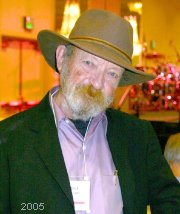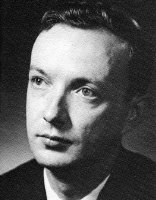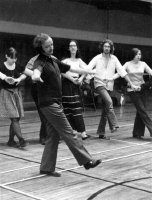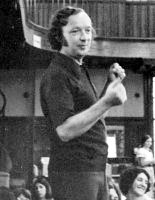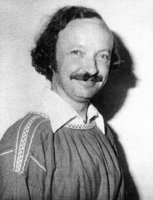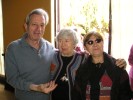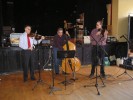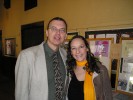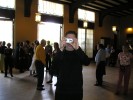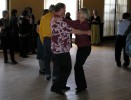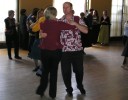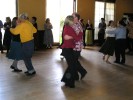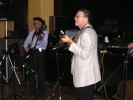|
Dick Crum
|
|
CLICK AN IMAGE FOR LARGER VIEW
Richard George "Dick" Crum was born in the United States on December 8, 1928, of German-Irish extraction and was raised in a Romanian neighborhood in St. Paul, Minnesota, where he attended Romanian school at the Romanian church. He was the oldest of five children. At an early age, he played with Romanian-speaking youngsters, attended language classes with them, and won their respect as someone interested in learning their dances and culture, as did his sister, Lois. Dick and Lois also went to the St. Louis, Missouri, Folk Dance Festival and traveled to Hibbing and Chisholm, Minnesota, for Serbian Days. When their parents lived in St. Petersburg, Florida, for a few years, their mom, Florence (Fee Fee) Crum taught folk dancing in a group there.
Dick started folk dancing in September, 1947, at a group meeting at the International Institute of St. Paul, Minnesota, whose instructor was Morry Gelman. There he saw Gordon Engler dancing. He also attended the University Folk Dancers at the University of Minnesota in Minneapolis. There, his instructors were Morry Gelman and Dr. Ralph Piper. Morry also was the instructor at another Minneapolis session that Dick attended, the YMCA International Folk Dance Group. At the YMCA in 1950, he participated in a special kolo session led by Michael Herman of New York City.
He eventually was a teacher at an Arthur Murray studio. From 1950, he was with the Duquesne University Tamburitzans for many years, first as a dancer, then as choreographer and technical adviser. During Thanksgiving weekend in 1951, he attended the first annual Kolo Festival in New York City, sponsored by the Folk Dance House (founded by Michael and Mary Ann Herman). Dick was the program director of the Festival of Nations at St. Paul, Minnesota, in 1952 where he mastered dance dialects of many styles of international dance. He also was a choreographer and consultant for the AMAN Folk Ensemble (aka, AMAN International Music and Dance Company). He moved to Los Angeles, California, in 1972.
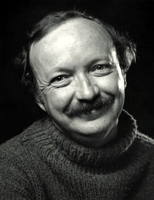 Dick was a perennial favorite teacher among folk dancers beginning in 1951. He made seven research trips to the Balkan countries, doing field work and formal research with many different groups and from village dancers to exhibition ensemble choreographers.
Dick was a perennial favorite teacher among folk dancers beginning in 1951. He made seven research trips to the Balkan countries, doing field work and formal research with many different groups and from village dancers to exhibition ensemble choreographers.
Because of his interest in Slavic languages, he studied and received a Bachelor's degree in Romance Languages from the University of Pittsburgh and an Master's degree in Slavic Languages and Literature at Harvard University.
He taught Balkan dance at all the major folk dance camps in the United States and Canada and for innumerable master classes at colleges and universities. Not only was he a folk dance specialist and authority on Balkan dance, but published a collection of Yugoslav folk songs for recorder and voice. Interestingly, Dick early on taught Slovenian couple dances but rapidly shifted to non-partner dances from Serbia, Croatia, Macedonia, Bulgaria, and Romania. His research interests included virtually all of Europe.
Dick's interest in Balkan dance was threefold:
- Ethnographic
- Recording dances as they are danced by native dancers, studying dances in their natural context.
- Choreographic
- Presenting dances on stage, involving esthetics and dance adaptation for the stage and for non-dancing audiences.
- Recreational
- United States- and Canadian-type recreational folk dance, utilizing ethnographic and choreographic dances for recreation, physical education, and fun!
For years, Dick was an editor for Agnew Tech-Tran, a foreign-language translation service agency in Los Angeles, California. In addition to English, Dick spoke Bulgarian, Macedonian, Serbo-Croatian, Slovenian, Spanish, and Romanian, and had a working knowledge of Brazilian, Chinese, German, Hungarian, Indonesian, Italian, Polish, Portuguese, Russian, Swedish, and several other languages. He even knew Old Church Slavonic – all 1,300 surviving words of that now unspoken language.
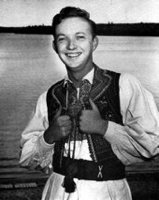
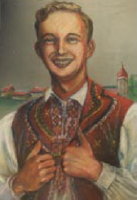 At a conference in 1996, Dick served as a panelist at a convening of the National Endowment for the Arts entitled "Vernacular Dance in America," which looked at the informal structures that support dance acivity.
At a conference in 1996, Dick served as a panelist at a convening of the National Endowment for the Arts entitled "Vernacular Dance in America," which looked at the informal structures that support dance acivity.
In 1999, the board of the East European Folklife Center (EEFC) recognized Dick Crum with a certificate for his lifetime of service to Balkan Music and Dance and his contribution to understanding of cultures. The National Folk Organization (NFO) honored Dick at their May 2002 Annual Conference in Rocklin, California. In a booklet produced by NFO president, Vonnie Brown, "A Tribute to Dick Crum," Dick is quoted, "It is our responsibility to be well informed about the material we are handling. The steps are only one dimension. It is vital we consider the dance within its cultural context." Vonnie also included a portion of an ongoing poem about Dick that begins, "Dick, you scaled the mountain without a stop; you stuck to your dream and reached the top. You cast your spell and made your mark; you are the master and our patriarch!" She also included a list of more than 190 dances that Dick had taught (see below), some "Crums of Wisdom," that included "You could spend your life trying to be Bulgarian, but you'd never make it. No way!" In another booklet, "Crum Table Trivia," produced at the same time, Vonnie wrote a 15-question "Crumisms Quiz."
Some of Dick's "Crumisms" are:
- "Bloop-bloops"
- "By mutual consent of the man"
- "Cranch"
- "Dance inside your shoes"
- "Dash, dot, dot"
- "Embroidery" (an embellishment on the basic step pattern)
- "Ethnic police" (fictional character who patrols class for foot shushing)
- "Ethnochoreo symmetry" (to indicate the same footwork in the opposite direction)
- "Ethnographical vortex"
- "Get your papers here"
- "Great ink pad in the sky"
- "Ker-plop"
- "Look less non-Serbian"
- "Mixed pickles" (or "Kris Kringle" during the Christmas season)
- "No shushing"
- "Old friend"
- "Pantherine movement"
- "Period. Paragraph."
- "Plain vanilla" that morphed into "Plain yogurt" in later years
- "Sandwich"
- "Shoulders back; earlobes upright"
- "Sore toe"
- "Strike a Pan-Hellenic pose"
- "...that lurk behind every step-hop in the syllabus of life."
- "Your other left foot"
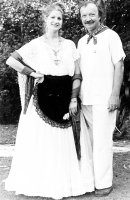
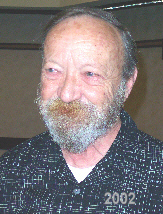 Ed Ableson of New York recalls that Dick was doing Orijent (a 'dance' he had choreographed for the Duquesne University Tamburitzans) when another dancer – obviously not knowing who he was – suggested that "if he didn't know the dance, he should go to the end of the line or follow behind!" Jon Spratt says that Dick told them that he had joined a group called "procrastinators;" they would meet as soon as they get around to it. Wally Washington of Texas relates that Dick was teaching a dance that was to be done flat-footed so he was saying "flat, flat, flat, flat" to encourage the dancers to do the steps flat-footed; when they were to go backwards, Dick cued "go back, talf, talf, talf, talf." Yves Moreau says "There is no doubt that I based a lot of my teaching techniques and methods on Dick's style and took it as a great compliment and honor when people would compare me to him." John Filcich had this poignant comment at the L.A Tamburitza Extravaganza in September of 2005: "Aren't we all glad that lady luck sent Dick Crum our way!"
Ed Ableson of New York recalls that Dick was doing Orijent (a 'dance' he had choreographed for the Duquesne University Tamburitzans) when another dancer – obviously not knowing who he was – suggested that "if he didn't know the dance, he should go to the end of the line or follow behind!" Jon Spratt says that Dick told them that he had joined a group called "procrastinators;" they would meet as soon as they get around to it. Wally Washington of Texas relates that Dick was teaching a dance that was to be done flat-footed so he was saying "flat, flat, flat, flat" to encourage the dancers to do the steps flat-footed; when they were to go backwards, Dick cued "go back, talf, talf, talf, talf." Yves Moreau says "There is no doubt that I based a lot of my teaching techniques and methods on Dick's style and took it as a great compliment and honor when people would compare me to him." John Filcich had this poignant comment at the L.A Tamburitza Extravaganza in September of 2005: "Aren't we all glad that lady luck sent Dick Crum our way!"
For all his seriousness about folklore, however, Dick was not beyond humor. At times he would wear a vest with "Colorful Ethnic Native" on the back. A workshop he gave titled "From Folklore to Fakelore" was a hilarious, hands-and feet-on demonstration of how true folk dance "evolves" from village amusement to some unrecognizable balletic enterprise suitable for touring and tourists. Dick also was known for interjecting humor into his dance instruction.
Maybe the epitome of Dick's humorous bent can be found in the "Hungarian Waltz Quadrille," in collaboration with Gordon Engler, which originally appeared in a spoof edition edited by Ralph Page of Mary Ann Herman's Maine Folk Dance Camp daily newsletter, the Pioneer Press, in 1962.
Hungarian Waltz Quadrille
Record: Soon available from Folk Dance House. In the meantime Acme LP 412, Side 1, Band 3, "Rosebud Waltz," will serve the purpose, as long as you remember to omit Meas. 22-23 of the second and third repeats of music "A" and do a "dip-point-pause" between figures 3 and 4. "Rosebud Waltz" must be speeded up a little.
Formation: 17 people in a square, facing upright. Boys hands on girls; girls hands on boys.
Background Notes: This Waltz Quadrille could be found everywhere in Budapest at the turn of the century, but during the reign of King Wencelas the Good, dancing was forbidden except in licensed cafeterias, or szésjészeréléttén császélihögyőrtók as they were commonly called. One of the king's chambermaids was discovered cowering under a wheelbarrow in Brussels in 1948, and it was from her that Andor Czompo learned this lovely old dance.
Part I: All couples promenade face to face around the room, gradually forming a heart-shaped pattern on the floor.
Part II: Social dance position. Men give hands to partners who return them at once to their original owners. Ladies repeat same figure with opposite footwork. Step is a "bounce-dip-trip-point" with an accent on the count "and." Remember the formula "WHO the HECK do you THINK YOU are"?
Part III: "Kiskutyá" step in place for men. "Hulyébűkös" step for women. Hands are opposite hips during this portion of the dance.
Part IV: Everyone form a large arch with everyone passing through backwards holding right hands around partner's wrists. Continue arching until fatigue sets in, or end of record. Shout "Ho!" at the end to give a native Hungarian flavor to the dance.
Styling Notes: The most difficult part of the Hungarian Waltz Quadrille is, of course, the "frocs" step which does require a great deal of practice for proper execution. It is suggested that dancers practice with two chairs side by side, standing on tiptoe on one, flinging left leg up over own right shoulder (ct. 1), then down again, then hop on same toe onto the other chair, bringing leg down again with an arch. Repeated practice of this will eventually develop the characteristic style so important to this dance.
Dick reports that he and Gordon Engler wrote take-offs on every section of the Pioneer Press (Ralph Page's report on the Maine Folk Dance Camp's previous day's activities, Henry Lash's recipe page, Mary Bunning's handicraft page, the day's dance descriptions, etc.). Then one night they waited till the Pioneer Press had been run, collated, and placed on the tables for campers' breakfast reading.
Finally Ralph Page, who edited the newsletter, finished his cigar and went to bed. Then Dick and Gordon went to work: gathered up all the legitimate copies and stashed them, typed up the stencils for their spoof, ran off their version on the mimeo, collated it, and placed it on the tables.
It was past dawn. They didn't bother to go to bed. When the first campers drifted in for breakfast, fully a half-dozen of them read the spoof and had no idea it was not serious! Finally, a single loud burst of laughter announced that somebody had caught on.
The following is attributed to Dick's quick wit:
- Beginning dancer: Knows nothing.
- Intermediate dancer: Knows everything, but is too good to dance with beginners.
- Hotshot dancer: Too good to dance with anyone.
- Advanced dancer: Dances everything, especially with beginners.
Dick was also leader of the "Ethnic Police," complete with helmet, badge, and whistle given to him by his groupies in Minnesota at the Memorial Day Folkdance Retreat in May of 1979. He also used fictional characters in his teaching, such as "Harald J. Underfoot (Ethnic Choreologist doing a statistical comparative analysis on the Serbian kolo and exploding suares, known to lurk and evesdrop)" and "Doris Ding-dong."
Dick consulted for and supervised many fine recordings of ethnic dance music on the Folk Dancer, Xopo, and Du-Tam labels, which are available from your local folk dance recording outlet.
Among Dick's publications, articles, record syllabi, and workshop syllabi are
- A review of Slovenski ljudski plesi (2 vols.) with Josef Brožek. Volume I, Slovenski ljudski plesi primorske, by Marija Šuštar; Volume II, Slovenski ljudski plesi koroske, by France Marolt and Marija Šuštar (Ljubljana, 1958). Journal of American Folklore, LXXII (1959), 362-363.
- "'Authenticity' in Podravina Dancing–A.D. 1868." The Tamburitzan, III, No. 3 (1960), 2.
- "Balkan Dance." Folkdance Progression, eds. Miriam Lidster and Ester Tamburini, Belmont, 1965, 3-15.
- "Balun-Istrian Folk Dance." The Tamburitzan, III, No. 4 (1960), 2.
- "Costumes." Viltis, 55:1 (Mar-Apr. 1955), p.14.
- "Dances of the Baranja." The Tamburitzan, III, No. 3 (1960), 1 and 8.
- "Dances of Prigorje." The Tamburitzan, III, No. 2 (1960), 1.
- Dick Crum Book, The: Vranjanka and Other Jugoslav Songs and Dances, 24pp, Hargill Music Press, New York, New York, 1957 (reprinted 1958).
- "Isn't it too bad that the old dances are dying out?" Let's Dance, Nov. 1974, p.4-5.
- "No Kissing Allowed in School!" A Virginia Dancing School in 1784 (Co-author)
- Old-Tyme Kolos. Softcover. Los Angeles, California: Tamburitza Extravaganza, 1993. (22 dance descriptions.)
- "Some Backgrouind on the Kolo in the United States." Viltis, XII (1954), p.4-5.
- "Some Notes on the Dances of Medjimure." The Tamburitzan, III, No. 2 (1960), p.8.
- "The Rŭčenica." Folk Dance Scene, Volume 19, Number 3 (1984), p.2-3.
Dick was last seen at selected folk dance conferences, principally in a Master-of-Ceremonies role. He passed away at home on December 12, 2005, at the age of 77, from pneumonia. His ashes were interred in a family space in St. Paul, Minnesota. He is missed by all.
Nick Jordanoff's family were special friends of Dick. Nick sent an e-mail that reads in part: "It's been a long time since we met in California – light years ago. As you could imagine, the death of Dick [Crum] was devastating to me since we had been so close all of our lives. From the time he came to Pittsburgh he basically 'lived' at our home, picking my mother's brain on all things Bulgarian until the time of his death. The interesting thing about that time was that I had made a donation to my wife's children chorus for a scholarship in the name of great teachers that I had in mylife – and that was Dick. I had sent him an e-mail to him apologizing for this and I know how humble he was about this sort of thing. This happened in November and I did not get a reply from him, so I sent several more e-mails and I received no response. This was very unusual, since we made contact at least once a week via e-mail. Whenever he would come East, he would stop for a day and it would end up close to a week. I can not tell you what a loss this was to me personally and to my wife and to my three sons, Nick, Iliya, and Greg. They just could not believe that 'Uncle Dick from out of town' had passed away."
The UCLA Ethnomusicology Archive received part of Dick Crum's personal phonograph collection in 2007. This collection consists of more than 1,300 commercially-produced phonograph recordings (LPs, 78s, 45s) primarily from Eastern Europe. Many of these albums are no longer in print, or are difficult to purchase. The items are not online; you must visit the contributing institution to view them. The collection materials are in English, Croatian, Bulgarian, Serbian, and Greek.
Dances Dick taught include
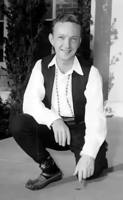
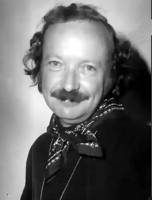 Ačano mlada mevesto,
Ajd' na lijevo,
Ajde noga za nogama,
Alunelul,
Ana Lugojana,
Arap,
Ardeleana cu Figuri,
Arkan,
Baba Djurdja,
Bačko kolo,
Ballos,
Balun,
Banatski madjarac,
Bătrinescu (Bătrinească),
Bela Rada,
Bibersko kolo,
Bitoljka,
Bohinjska sustarska,
Boiereasca,
Bosarka,
Brîul Pe Șase (Brîulețul din Muscel),
Bučimiš
Bunjevačko momačko kolo,
Ca la Balta,
Ca la Ușa Cortului,
Čačak,
Čačak (Long),
Calușerul,
Čamčeto,
Cigančica,
Ciganka,
Cigansko horo,
Ciganskoto,
Ciocârlanul,
Ćiro,
Čoček (Ramo Ramo),
Cone Milo čedo,
Corăgheasca,
Crnagorka,
Csárdás,
Čuješ mala (Šušu mile),
Čukaričko kokonješte,
Čukarište kokonješte,
Czardáš,
Dajčovo horo,
Deînvîtit,
Deninka,
De vam kazem bračo moja (Pepper Dance),
Devetorka (Tri godini),
Devojče devojče,
Dhrtavac,
Divna divna,
Divotinsko horo,
Djurdjevka,
Doiul,
Dopasi,
Dravčevka,
Dorčolka kolo,
Drmeš,
Drmeš for Three,
Drmeš iz Zdenčine,
Dučec,
Dunavsko horo,
Dura,
Đurđevka,
Džangurica,
Ekizlisko horo,
Eleno mome,
Erdeljanka,
Ersko kolo,
Fatiše kolo,
Gaitanaki,
Gankino horo,
Gelsko horo,
Godečki čačak,
Goja (Goja ples),
Gružanka,
Haj Haj bože daj,
Hajd' na lijevo,
Homoljanka lolo,
Hopa hopa,
Hora de la Câmpulung,
Hora Dreaptă,
Hora Mare,
Horo-rŭčenica,
Igraj kolo (Igra kolo),
Igraj kolo na dvadeset i Dva,
Igrajte nam muzikaši,
Igrale se delije,
Întoarsă,
Jambolsko pajduško horo,
Jambolsko pajduško II,
Jeftanovićevo kolo,
Jove malaj mome,
Jovano Jovanke,
Kabanica i seksera,
Kačerac,
Kalja kaljino,
Kalajdžisko oro,
Kalendara kolo (Kolo kalendara),
Karagouna,
Kasapsko horo,
Katuše mome katuše,
Kazlanŭško mŭko horo,
Keleruj,
Kilimarsko horo,
Kiša pada,
Kišbokazo,
Klimarsko horo,
Kokonješte (Kukunješće),
Kolenike,
Kolubarski vez,
Kopačka,
Kopčeto,
Korčovo,
Koso moja,
Kostursko oro,
Krecavi ketuš,
Kriči kriči tiček I,
Krivata,
Krivo kuče,
Krivo sadovsko horo,
Kukuneško horo,
Lesnoto oro,
Levačko kolo,
Lički Tanac,
Ličko kolo,
Ličko kukunješće,
Lile Lile,
Logovac,
Lomsko kolo,
Ludo kopano,
Madjarac,
Makazice,
Makedonsko evojče,
Malo kolo,
Mangupsko kolo,
Mazulinka,
Mehmede,
Milica kolo,
Minka,
Mista,
Moja diridika,
Moravsko kolo,
Mŭžko trojno,
Narodno horo,
Natalijino kolo,
Nebesko kolo,
Ne odi dzemo,
Neda grivne,
Neda voda nalivala,
New šest,
Niška banja,
Nojkatoliš,
Obični rej,
Oj jelo Jelena,
Opša,
Opšaj diri,
Ordan sedi,
Orijent,
Oromnia,
Pajduška,
Petrunino horo,
Piperana,
Pirot Dance Medley (Serbian Medley II - Što mi omilelo, Pošla rumena, Lile lile, Piperana),
Pleskovac kolo,
Plevensko pajduško,
Pljeskavac I,
Pljeskavac II,
Plovdivska kopanica,
Po zelenoj trati,
Pobelelo pole,
Pokupski drmeš,
Polster Tanc,
Posavski drmeš,
Posavski ples,
Poskakuša,
Poskok,
Pošla rumena,
Potrkan ples,
Povrateno,
Povurnato horo,
Pravo Šopsko oro,
Pravo Trakijsko horo,
Preplet (Mangupsko),
Presjekača,
Purtata Fetelor,
Pušnoto oro,
Pušteno oro,
Răčenica for Three,
Radikalka (Devojačko kolo, Haj! Haj! bože daj, Radikalko kolo, Rukavice s Prstima),
Radikalko kolo,
Radničko kolo,
Ratevka,
Razgranjala grana Jorgovana,
Razvruštanata,
Ripanjsko kolo (Kolo from Ripanj),
Ripna maca,
Rokoko kolo,
Ruka ot Kranovo,
Rukavice,
Rumenka,
Rumunjsko kolo,
Ruse kose,
Ruzmarin,
Sa,
Sărăcia,
Sarajevka,
Sârba in Trei Ciocane,
Sareni chorapi,
Savamaljsko kolo,
Scoteš,
Seljančica (Đačko kolo),
Serbian Medley III (Divna divna, Krivo kuče, Lomsko kolo, and Vasino kolo),
Šestinski drmeš,
Šestorka from Bela Palanka,
Šetnja,
Sitna Kopanica,
Sitno Šopsko horo,
Skudrinka,
Slavjanka,
Slavonian Medley (including Presjekača, Ajde noga za nogama, Slavonsko kolo, Moja diridika),
Slavonsko kolo (Dvoransko kolo),
Slovenian Waltz,
Sofisko Šopsko horo,
Šokačko malo kolo,
Šop from Trun,
Šotiš,
Srbijanka,
Šroteš,
Srpkinja,
Štajeriš,
Stankino horo,
Stari šotiš,
Staro sito i korito,
Štjeriš,
Što mi e milo em drago,
Što mi omilelo,
Suata rjaka,
Sukačko kolo,
Šuštarska,
Šušu mile,
Šuster Polka,
Svatbena Polka,
Svatbeni rejc,
Svrljiski čačak,
Syrtos silivrianos,
Syrtos Rhodu,
Ta potresena,
Tandora,
Țărăncuța,
Ti momo,
Trava trava,
Trgovačko,
Tri godini,
Trite pâti,
Trite pâti from Gergebunar,
Trojanac,
Trŭgnala Rumjana,
Tsakonikos,
Tsamikos from Epirus (Sixteen-count Tsamikos),
Turopoljski drmeš,
U Šest koraka (Moravac),
Užicka čarlama,
Veliko kolo,
Venderti,
Vlata,
Vranjanka,
Za poyas,
Zaječarka,
Zaplanjski čačak,
Zaplet,
Žensko krsteno,
Zetovsko oro,
Zibnšrit,
Žikino kolo,
and
Žita kolo.
Ačano mlada mevesto,
Ajd' na lijevo,
Ajde noga za nogama,
Alunelul,
Ana Lugojana,
Arap,
Ardeleana cu Figuri,
Arkan,
Baba Djurdja,
Bačko kolo,
Ballos,
Balun,
Banatski madjarac,
Bătrinescu (Bătrinească),
Bela Rada,
Bibersko kolo,
Bitoljka,
Bohinjska sustarska,
Boiereasca,
Bosarka,
Brîul Pe Șase (Brîulețul din Muscel),
Bučimiš
Bunjevačko momačko kolo,
Ca la Balta,
Ca la Ușa Cortului,
Čačak,
Čačak (Long),
Calușerul,
Čamčeto,
Cigančica,
Ciganka,
Cigansko horo,
Ciganskoto,
Ciocârlanul,
Ćiro,
Čoček (Ramo Ramo),
Cone Milo čedo,
Corăgheasca,
Crnagorka,
Csárdás,
Čuješ mala (Šušu mile),
Čukaričko kokonješte,
Čukarište kokonješte,
Czardáš,
Dajčovo horo,
Deînvîtit,
Deninka,
De vam kazem bračo moja (Pepper Dance),
Devetorka (Tri godini),
Devojče devojče,
Dhrtavac,
Divna divna,
Divotinsko horo,
Djurdjevka,
Doiul,
Dopasi,
Dravčevka,
Dorčolka kolo,
Drmeš,
Drmeš for Three,
Drmeš iz Zdenčine,
Dučec,
Dunavsko horo,
Dura,
Đurđevka,
Džangurica,
Ekizlisko horo,
Eleno mome,
Erdeljanka,
Ersko kolo,
Fatiše kolo,
Gaitanaki,
Gankino horo,
Gelsko horo,
Godečki čačak,
Goja (Goja ples),
Gružanka,
Haj Haj bože daj,
Hajd' na lijevo,
Homoljanka lolo,
Hopa hopa,
Hora de la Câmpulung,
Hora Dreaptă,
Hora Mare,
Horo-rŭčenica,
Igraj kolo (Igra kolo),
Igraj kolo na dvadeset i Dva,
Igrajte nam muzikaši,
Igrale se delije,
Întoarsă,
Jambolsko pajduško horo,
Jambolsko pajduško II,
Jeftanovićevo kolo,
Jove malaj mome,
Jovano Jovanke,
Kabanica i seksera,
Kačerac,
Kalja kaljino,
Kalajdžisko oro,
Kalendara kolo (Kolo kalendara),
Karagouna,
Kasapsko horo,
Katuše mome katuše,
Kazlanŭško mŭko horo,
Keleruj,
Kilimarsko horo,
Kiša pada,
Kišbokazo,
Klimarsko horo,
Kokonješte (Kukunješće),
Kolenike,
Kolubarski vez,
Kopačka,
Kopčeto,
Korčovo,
Koso moja,
Kostursko oro,
Krecavi ketuš,
Kriči kriči tiček I,
Krivata,
Krivo kuče,
Krivo sadovsko horo,
Kukuneško horo,
Lesnoto oro,
Levačko kolo,
Lički Tanac,
Ličko kolo,
Ličko kukunješće,
Lile Lile,
Logovac,
Lomsko kolo,
Ludo kopano,
Madjarac,
Makazice,
Makedonsko evojče,
Malo kolo,
Mangupsko kolo,
Mazulinka,
Mehmede,
Milica kolo,
Minka,
Mista,
Moja diridika,
Moravsko kolo,
Mŭžko trojno,
Narodno horo,
Natalijino kolo,
Nebesko kolo,
Ne odi dzemo,
Neda grivne,
Neda voda nalivala,
New šest,
Niška banja,
Nojkatoliš,
Obični rej,
Oj jelo Jelena,
Opša,
Opšaj diri,
Ordan sedi,
Orijent,
Oromnia,
Pajduška,
Petrunino horo,
Piperana,
Pirot Dance Medley (Serbian Medley II - Što mi omilelo, Pošla rumena, Lile lile, Piperana),
Pleskovac kolo,
Plevensko pajduško,
Pljeskavac I,
Pljeskavac II,
Plovdivska kopanica,
Po zelenoj trati,
Pobelelo pole,
Pokupski drmeš,
Polster Tanc,
Posavski drmeš,
Posavski ples,
Poskakuša,
Poskok,
Pošla rumena,
Potrkan ples,
Povrateno,
Povurnato horo,
Pravo Šopsko oro,
Pravo Trakijsko horo,
Preplet (Mangupsko),
Presjekača,
Purtata Fetelor,
Pušnoto oro,
Pušteno oro,
Răčenica for Three,
Radikalka (Devojačko kolo, Haj! Haj! bože daj, Radikalko kolo, Rukavice s Prstima),
Radikalko kolo,
Radničko kolo,
Ratevka,
Razgranjala grana Jorgovana,
Razvruštanata,
Ripanjsko kolo (Kolo from Ripanj),
Ripna maca,
Rokoko kolo,
Ruka ot Kranovo,
Rukavice,
Rumenka,
Rumunjsko kolo,
Ruse kose,
Ruzmarin,
Sa,
Sărăcia,
Sarajevka,
Sârba in Trei Ciocane,
Sareni chorapi,
Savamaljsko kolo,
Scoteš,
Seljančica (Đačko kolo),
Serbian Medley III (Divna divna, Krivo kuče, Lomsko kolo, and Vasino kolo),
Šestinski drmeš,
Šestorka from Bela Palanka,
Šetnja,
Sitna Kopanica,
Sitno Šopsko horo,
Skudrinka,
Slavjanka,
Slavonian Medley (including Presjekača, Ajde noga za nogama, Slavonsko kolo, Moja diridika),
Slavonsko kolo (Dvoransko kolo),
Slovenian Waltz,
Sofisko Šopsko horo,
Šokačko malo kolo,
Šop from Trun,
Šotiš,
Srbijanka,
Šroteš,
Srpkinja,
Štajeriš,
Stankino horo,
Stari šotiš,
Staro sito i korito,
Štjeriš,
Što mi e milo em drago,
Što mi omilelo,
Suata rjaka,
Sukačko kolo,
Šuštarska,
Šušu mile,
Šuster Polka,
Svatbena Polka,
Svatbeni rejc,
Svrljiski čačak,
Syrtos silivrianos,
Syrtos Rhodu,
Ta potresena,
Tandora,
Țărăncuța,
Ti momo,
Trava trava,
Trgovačko,
Tri godini,
Trite pâti,
Trite pâti from Gergebunar,
Trojanac,
Trŭgnala Rumjana,
Tsakonikos,
Tsamikos from Epirus (Sixteen-count Tsamikos),
Turopoljski drmeš,
U Šest koraka (Moravac),
Užicka čarlama,
Veliko kolo,
Venderti,
Vlata,
Vranjanka,
Za poyas,
Zaječarka,
Zaplanjski čačak,
Zaplet,
Žensko krsteno,
Zetovsko oro,
Zibnšrit,
Žikino kolo,
and
Žita kolo.
A Tribute to Dick Crum
By Vonnie R. Brown
May 17, 2002
Dick, you scaled the mountain without a stop,
You stuck to your dream and reached the top.
You cast your spell and made your mark,
You are the master and our patriarch!
Your ethics are impeccable, you have what it takes to stay.
You never hustle workshops or annoy in any way.
You have the uncanny ability "to plant and harvest the crops."
You write and speak with brilliance, your dance notes are always tops.
You never had an ego, cuz you always knew so much.
Humility came natural and was another special touch.
The ultimate professional, a master of your trade,
You were always so deserving of much more than your were paid.
Your shoes we call magic and the old floppy hat
Are visions we have of the man who has "that."
The way that you move, your body and mind
All make you quite sexy and one of a kind.
Dick is known for Balkan, but he does much more.
His talents are many and go beyond the dance floor.
He's fluent in twelve languages plus Minnesotan.
He dances the tapitio and even the jota.
His vocabulary is incredible; his IQ off the charts,
And his wit and humor delight us and makes for healthy hearts.
A little known fact, but it is very much the truth,
Dick studied Arthur Murray when he was just a youth.
His parents decided he needed some polish and graces
So they enrolled him in class to meet some new faces.
He became proficient in ballroom and does a mean swing,
He cortes and twinkles and does all of those things.
Dick taught us great dances, two hundred or more.
He taught us the steps and also the lore.
He taught us the difference between fakelore and folklore
And we came to the conclusion the fake is a bore.
Dick taught us such classics and taught them so well,
We mastered the dances we thought were from hell.
He taught us odd rhythms and wild, weird beats.
He taught us to listen and to have sneaky feet.
He taught us the čukče, drmeš, and twizzle,
The kerplop, mixed pickles, and a whole lot of sizzle.
He taught us the oro, the hora, and pravo,
The horo, the kolo, and all with much bravo.
Dick's "Crumisms" are amazing and very funny too,
His methods are so effective as are his clever cues.
The charcters he created are infamous and fun,
We feel like we're related when all is said and done.
Harold Underfoot, the annoying nerdy one,
Comes armed with pad and pencil and questions by the ton.
Now Doris Ding Dong is the rather dizzy lass;
Seems Doris is always in line but never in class.
Harold and Doris are legends indeed,
They are basically harmless but cause great fatigue.
Those icons Dick created are so alive and real
That any close encounter is really no big deal.
Dick is the mentor we all wish we could be,
And although we try to copy him, we seem to lack the key.
He has the right ingredients, that very special knack,
To gather all us folks around and then ably lead the pack.
Dick weaves his magic and spins his tales,
He captivates and enlightens and never fails.
He teaches our head as well as our feet,
And riveted we sit on the edge of our seat.
A book would be better but this tells you in part
How all of us feel deep in our hearts.
So from Harold and Doris and all of us fans,
Tonight we say "Thank you!" to a really great man.
No tribute is adequate, no honor too great,
No words can express the love for this mate.
With respect and gratitude we salute and toast
The master, a legend, the best coast to coast.
Here are several photos from the Dick Crum Memorial Party held in Pasadena on March 4, 2006.
CLICK AN IMAGE TO ENLARGE
(Photos courtesy of Laurie Allen)
